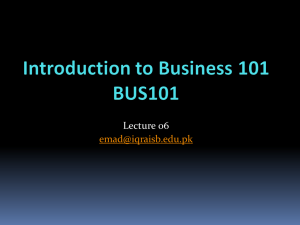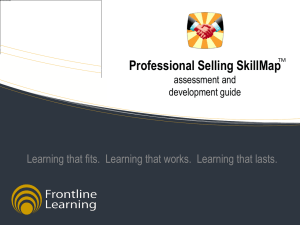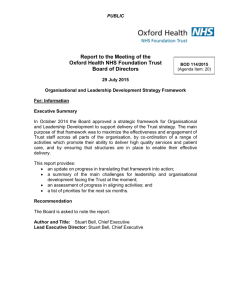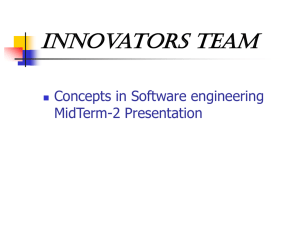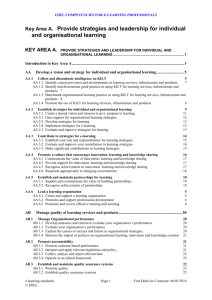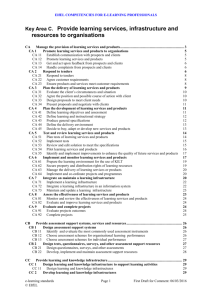HRM At Work: Student Notes Chapter 9: Learning and Development
advertisement
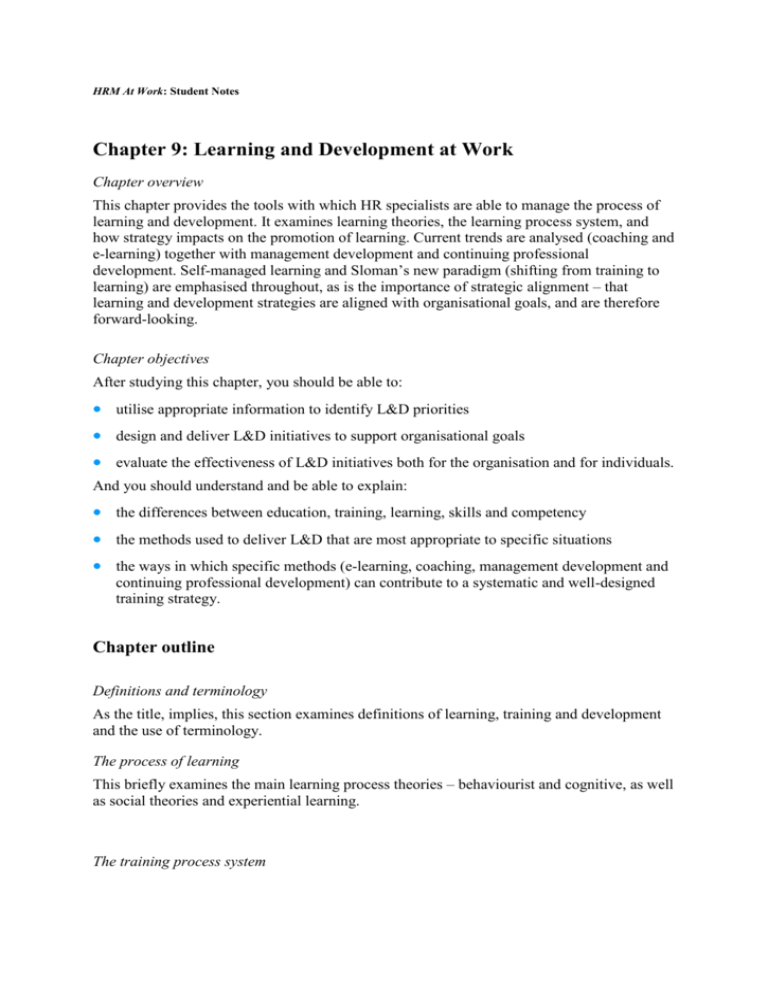
HRM At Work: Student Notes Chapter 9: Learning and Development at Work Chapter overview This chapter provides the tools with which HR specialists are able to manage the process of learning and development. It examines learning theories, the learning process system, and how strategy impacts on the promotion of learning. Current trends are analysed (coaching and e-learning) together with management development and continuing professional development. Self-managed learning and Sloman’s new paradigm (shifting from training to learning) are emphasised throughout, as is the importance of strategic alignment – that learning and development strategies are aligned with organisational goals, and are therefore forward-looking. Chapter objectives After studying this chapter, you should be able to: utilise appropriate information to identify L&D priorities design and deliver L&D initiatives to support organisational goals evaluate the effectiveness of L&D initiatives both for the organisation and for individuals. And you should understand and be able to explain: the differences between education, training, learning, skills and competency the methods used to deliver L&D that are most appropriate to specific situations the ways in which specific methods (e-learning, coaching, management development and continuing professional development) can contribute to a systematic and well-designed training strategy. Chapter outline Definitions and terminology As the title, implies, this section examines definitions of learning, training and development and the use of terminology. The process of learning This briefly examines the main learning process theories – behaviourist and cognitive, as well as social theories and experiential learning. The training process system This section analyses the traditional systematic training model which comprises four steps: identifying training and learning needs, devising a learning plan, implementing the training event, and lastly, evaluating outcomes. Criticism of the system is examined, together with problems encountered at each stage of the process. Much of this section is devoted to ‘devising a learning plan’, and an overview of the main learning interventions is presented with suggestions on when each might be most usefully employed. The critical importance of evaluation is emphasised, and five levels are discussed, together with the need for careful consideration of which levels should be utilised. Promoting a learning and development culture This is increasingly seen as pivotal to organisational success. The section also looks at barriers to implementing an L&D culture. The strategic role of L&D professionals is stressed, together with the need for many to reposition themselves within the organisation. The role of the line manager Line managers now play an increasingly central role in the delivery of many HR functions. Here we examine the advantages of line management involvement in L&D, as well as the barriers to their involvement. Trends and developments in learning interventions This section critically analyses recent trends in learning interventions, picking out coaching and mentoring, e-learning, management development, and continuing profession development. Conclusions This draws together the main messages from the chapter, in particular the strategic role for HRD in promoting an L&D culture in the organisation, and adopting a systematic and wellorganised structure for managing L&D while facilitating the shift from training to learning. The point is made that all L&D interventions – particularly new trends – must be subject to robust evaluation, and that traditional methods remain the norm. Feedback on mini-questions Do you think it is possible for people to learn without being aware that they are learning? Do they need to consolidate the learning or relate it to abstract principles for learning to be effective? This question is designed to make you think about the ways in which learning takes place. Learning involves a process whereby the individual acquires knowledge and skills or undergoes a transition in attitudes. In answering the first question, you should surely be able to think of situations in which all three have occurred without your awareness. For example, someone moving from one culture or class to another will quickly assimilate new attitudes and knowledge without formal learning. Women in particular often possess valuable tacit skills, but frequently these are not recognised in the workplace. You ought to be able to analyse the value of such tacit skills. In considering the second question, you will also probably be able to think of times when you have attended a training course but then not had the opportunity to consolidate that learning back at the workplace. Computer training is an obvious example of this – without an opportunity to reinforce the skills, those skills can quickly be lost. You are also likely to be able to give examples of situations in which reference to abstract principles enhances effective learning. Being told to do something without knowing the reason does not usually make for effective performance. An example of this might be taken from call centres in which workers are told to follow the script. Without thorough understanding of the issues, they will be unable to cope if they go off script – as often happens. Keep a diary for a week noting all the times when you learned something new. Categorise these learning experiences according to the different learning theories outlined above. Make sure that you include all learning events, not just those taking place at work or in a formal situation. You may well be surprised at the amount of learning that goes unrecognised. The exercise is designed to test your understanding of each of the learning theories – behaviourist, cognitive learning, cybernetics and social learning theory. It may be that not all of your experiences provide a tight fit to each theory, and certain circumstances will span a number of theories. Choose what you think has been a successful lecture, and someone whom you feel to be a good lecturer, and identify the attributes of both that led to that evaluation. Can these attributes be taught to other people? Why/why not? This exercise will demonstrate good practice in delivering learning! The first part of the question is relatively straightforward. You should include characteristics of the lecturer (enthusiastic and knowledgeable) as well as issues around planning and delivery. In the latter case, this might involve devising a learning plan together with your trainer. Other issues could include the your own perception of the subject and of the lecturer. If the subject debated is one in which you are passionately interested, or the lecturer is attractive or distinguished (perhaps someone famous in the field, and/or an amusing orator), the lecture is highly likely to be viewed as ‘good’ whether or not best practice has been followed. The second part of the question asks whether the best attributes can be taught to other people. You are expected to divide characteristics into those that are transferable (such as clear aims and objectives, use of audiovisual aids, etc) from those that are not (such as charisma, style, enthusiasm or fame) and to say why certain attributes are not transferable. In a small group, brainstorm those factors that have facilitated and hindered learning for you. Compile the results and compare them with those presented by Mumford and Gold (2004, p.109). This is a piece of work that should result in important learning. After the small group brainstorms, it would be useful if your trainer brings the results together and classifies the factors listed as either positive or negative influences, and places them in order of importance. It is likely that the main barriers and promoters of learning will be those associated with others’ expectations – teachers’ self-fulfilling prophecies are particularly potent, and it is interesting to reflect on the source of confidence to succeed, or the lack of confidence associated with failure. This exercise is particularly interesting when carried out with those who lack any formal education or training. The range of significant others’ wielding influence may be large, and include parents, relatives, or colleagues at work, as well as teachers. In addition, we are all exposed to different opportunities for learning, through accident of birth, or merely accident. Do you think that this represents best practice? How would you improve on the BBC’s plans for effective valuation? On the face of it, the BBC’s plans are a model of excellence. However, you should be able to anticipate problems that can occur within the best-planned evaluation. In particular, there must be a system in place to ensure that all of those involved keep up their commitment and act on feedback, to guarantee that the system does not fall into disuse and that all stakeholders remain committed and involved. Work together in groups to devise an appropriate evaluation for a learning event that has recently taken place in your organisation or one with which you are familiar. This question should enable you and other students to draw together best practice on evaluation. In itself, the question is very straightforward. However, you should be careful to choose appropriate levels of evaluation – and not simply suggest that the event is evaluated at all five levels. Where you then choose only one or two levels of evaluation, you must justify your choice and explain the purpose of the evaluation, and who it is for – whether for the trainer, the departmental manager, or the directors of the company. Finally, you should anticipate the outcome of feedback of the evaluation. The BBC case study demonstrates this point admirably. Using the John Lewis Partnership case study, identify possible barriers to maintaining a programme of learning and development. Once again, this is a simple question that asks you only to consider the barriers to learning, drawing on material in the chapter as well as on material from the CIPD latest Learning and Development Annual Survey Report and the work of Purcell and Hutchinson on the role of the line manager. How can e-learning be used to improve worker skills and organisational performance? This question asks you to evaluate the worth of e-learning for the individual worker, and for the organisation. You should be able to describe the optimum conditions in which worker skills and organisational performance are enhanced by its use by drawing on your own experience as well as on the texts referred to in the chapter. You should also try to demonstrate knowledge of the situations in which e-learning is unlikely to be effective in improving worker skills and enhancing organisational performance. Such situations will include those affected by characteristics of the learners themselves (such as lack of familiarity with computers) as well as institutional barriers such as the reluctance of some trainers to embrace e-learning or not providing a human interface to supplement computeraccessed materials. As can be seen from the above, not all professionals value CPD as highly as others, and of those that do, not all engage with it. What motivates you to engage with CPD, and what are the barriers? Analyse the activities you engage in and consider whether there are others that might be useful to you. As can be seen from the section, there are as many barriers to CPD as there are motivations. You may be put off by the element of compulsion; you may alternatively not see its relevance. However, the most commonly-reported barrier is lack of time. Once you have read the section you should see the benefits of CPD and understand the importance of overcoming barriers (see Table 28 and the references to work by Sadler-Smith et al (2000). Those who value CPD and who engage in it are the most likely to be more successful in their chosen career.


